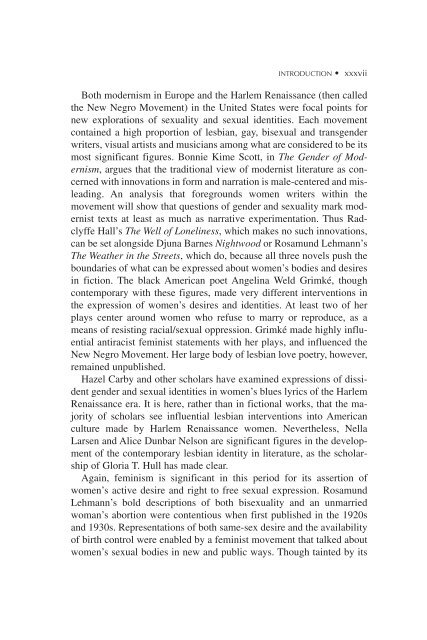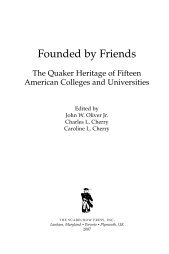Historical Dictionary of Lesbian Literature - Scarecrow Press
Historical Dictionary of Lesbian Literature - Scarecrow Press
Historical Dictionary of Lesbian Literature - Scarecrow Press
You also want an ePaper? Increase the reach of your titles
YUMPU automatically turns print PDFs into web optimized ePapers that Google loves.
INTRODUCTION • xxxvii<br />
Both modernism in Europe and the Harlem Renaissance (then called<br />
the New Negro Movement) in the United States were focal points for<br />
new explorations <strong>of</strong> sexuality and sexual identities. Each movement<br />
contained a high proportion <strong>of</strong> lesbian, gay, bisexual and transgender<br />
writers, visual artists and musicians among what are considered to be its<br />
most significant figures. Bonnie Kime Scott, in The Gender <strong>of</strong> Modernism,<br />
argues that the traditional view <strong>of</strong> modernist literature as concerned<br />
with innovations in form and narration is male-centered and misleading.<br />
An analysis that foregrounds women writers within the<br />
movement will show that questions <strong>of</strong> gender and sexuality mark modernist<br />
texts at least as much as narrative experimentation. Thus Radclyffe<br />
Hall’s The Well <strong>of</strong> Loneliness, which makes no such innovations,<br />
can be set alongside Djuna Barnes Nightwood or Rosamund Lehmann’s<br />
The Weather in the Streets, which do, because all three novels push the<br />
boundaries <strong>of</strong> what can be expressed about women’s bodies and desires<br />
in fiction. The black American poet Angelina Weld Grimké, though<br />
contemporary with these figures, made very different interventions in<br />
the expression <strong>of</strong> women’s desires and identities. At least two <strong>of</strong> her<br />
plays center around women who refuse to marry or reproduce, as a<br />
means <strong>of</strong> resisting racial/sexual oppression. Grimké made highly influential<br />
antiracist feminist statements with her plays, and influenced the<br />
New Negro Movement. Her large body <strong>of</strong> lesbian love poetry, however,<br />
remained unpublished.<br />
Hazel Carby and other scholars have examined expressions <strong>of</strong> dissident<br />
gender and sexual identities in women’s blues lyrics <strong>of</strong> the Harlem<br />
Renaissance era. It is here, rather than in fictional works, that the majority<br />
<strong>of</strong> scholars see influential lesbian interventions into American<br />
culture made by Harlem Renaissance women. Nevertheless, Nella<br />
Larsen and Alice Dunbar Nelson are significant figures in the development<br />
<strong>of</strong> the contemporary lesbian identity in literature, as the scholarship<br />
<strong>of</strong> Gloria T. Hull has made clear.<br />
Again, feminism is significant in this period for its assertion <strong>of</strong><br />
women’s active desire and right to free sexual expression. Rosamund<br />
Lehmann’s bold descriptions <strong>of</strong> both bisexuality and an unmarried<br />
woman’s abortion were contentious when first published in the 1920s<br />
and 1930s. Representations <strong>of</strong> both same-sex desire and the availability<br />
<strong>of</strong> birth control were enabled by a feminist movement that talked about<br />
women’s sexual bodies in new and public ways. Though tainted by its
















